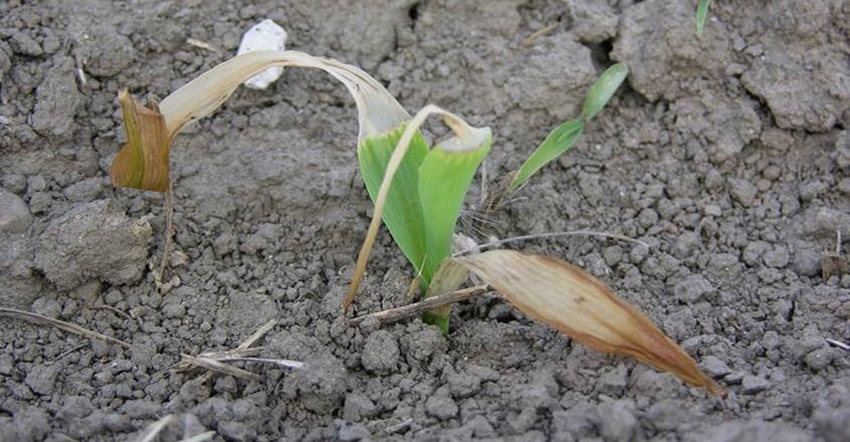
Dekalb agronomist Lance Tarochione says he received several reports of damage on recently emerged soybeans from a freeze that occurred May 9 in a region along the Interstate 74 corridor, stretching from Bloomington, Ill., west to Warren County.
According to University of Illinois crop sciences expert Emerson Nafziger, soybeans planted between about April 10 and April 22 had enough time and temperature to emerge, or to be in the process of emerging, by May 9. These suffered the most damage.
It’s a “told you so” moment for growers who don’t plant soybeans early, instead preferring to plant corn to avoid the risk of an early May freeze. While just-emerged soybeans usually handle brief freezes OK, the conditions that hit parts of northwest Illinois in May were far from brief, with temperatures dipping below 28 degrees F for over two and a half hours an inch above the soil, according to sensors in Monmouth, Ill.
“I’m not surprised we’ve got dead beans where temperatures stayed below 28 degrees for a while, but I am a little surprised how good most of the corn looks,” Tarochione says, noting in areas where farmers he works with are replanting soybeans, the corn doesn’t look bad enough to justify a replant.
He expected the corn to freeze off and regrow from still-living growing points below the soil, but he says this largely didn’t happen. One possibility is because the corn was “used to” the cold temperatures and soil conditions that have persisted across northern Illinois regardless of when a farmer planted, be it April 5 or May 9.
“If this corn would have been in 80-degree, beautiful conditions and growing like crazy, and then got hit with 28 degrees, it would have been a lot different,” he says.
Soybean recovery
While corn has growing points below the soil, all the growing points for soybeans are above ground. That makes newly emerged soybeans vulnerable. They brown within the first few days of being injured if the terminal growing point is dead on top. But Tarochione says that doesn’t mean the crop is a goner.
So long as the axillary buds remain, farmers don’t need to replant. Removing the terminal growing point allows for the growth of a Y-branch soybean plant that could outyield normal-looking soybeans, according to research from U of I crop sciences professor Fred Below.
“He [Below] used graduate students with scissors to go out and clip out the terminal bud, but if you were to remove the terminal bud on a seedling soybean plant at just the right time to release those two axillary buds, you’ll get a hardy bean plant that looks like a capital Y,” Tarochione explains.
He says for many of the farmers along that I-74 corridor who have called him, the freeze was complete: all the way up and down the soybean crop. This was evident after a few days, as some crops rotted and turned black or brown below the cotyledons.
“It’s just toast from there. But if the stem from the cotyledons down still looks healthy, then I think those axillary buds are still alive,” Tarochione says, concluding the tricky part is confirming that, because conditions must warm up first. “The soybeans aren’t growing, and you don’t know if it’s because they’re dead, or if it’s because it’s too cold. So we’ll have to wait and give it some time.”
Trickier still is waiting. He says some farmers prioritized replanting fields where 80% of soybeans were dead. For fields still in question, some of his growers opted to go ahead and replant, while others are still waiting.
“The only trouble with waiting is, ‘What if I can’t get back in the field until June?’ There, you start to get into a risk-benefit kind of analysis that varies from farmer to farmer. It’s a very personal decision,” Tarochione concludes.
About the Author(s)
You May Also Like




